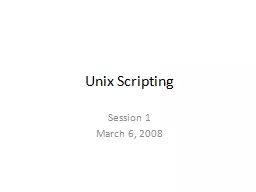PPT-Unix Shell Workshop
Author : min-jolicoeur | Published Date : 2017-06-09
Part 2 Loops shell scripts and Finding things Quick review OF UNIX COMMANDS ls list all files and directories in current directory p wd shows current locationdirectory
Presentation Embed Code
Download Presentation
Download Presentation The PPT/PDF document "Unix Shell Workshop" is the property of its rightful owner. Permission is granted to download and print the materials on this website for personal, non-commercial use only, and to display it on your personal computer provided you do not modify the materials and that you retain all copyright notices contained in the materials. By downloading content from our website, you accept the terms of this agreement.
Unix Shell Workshop: Transcript
Part 2 Loops shell scripts and Finding things Quick review OF UNIX COMMANDS ls list all files and directories in current directory p wd shows current locationdirectory mkdir. Shell be r din six w ite horses w en she comes Shell be r din six w ite horses w en she comes Shell be ridin six w ite horses ell be ridin six w ite horses Shell be ridin six w ite horses w en she comes Shell be w arin pin pajamas w en she comes etc Overview. 2. UNIX. UNIX is . a multi-user . and multi-tasking operating system.. Multi-tasking: Multiple processes can run concurrently.. Multi-user: . different users can read mails, copy files, and print all at once.. © George B. . Magklaras. - 2006 . The Norwegian . EMBnet. node,. The Biotechnology Centre of Oslo. What is UNIX (The history. ). Originated as a research project at AT&T Bell Labs in 1969 by Ken Thompson and Dennis Ritchie.. It's just picky about who it's friends are...''. -- Unknown, seen in .sigs around the world. Basics of the Unix/Linux Environment. Shells and Your Unix Environment. What is a shell?. Traditional user interface with the unix operating system…it interprets your typing . Unix Introduction. 2. Introduction. Unix-like system is everywhere. Linux. Android for smartphones. Google Chrome OS for . Chromebook. Web servers. OS X for MacBook/iMac . etc. iOS for iPhone/iPad . etc. WHAT WILL BE COVERED. UNIX/Linux Overview. Red Hat Enterprise Linux. ECC-UNIX accounts. How to Login . GUI Navigation. Applications. Command Line. Shell Commands and Create Text Files. File Permissions. 15CS35 . SEMESTER – III . 04-08-2016. Syllabus and course outcomes. Link for syllabus. Operating system. The . o. perating . s. ystem (. OS. ). is the most important program that runs on a computer. . Unix History. Developed by Dennis Ritchie and Ken Thompson at AT&T Bell Labs. Adapted some ideas from the . Multics. project in 1969. Design Features. Written in C – portable. Application program interface (API) –. Session 1. March 6, 2008. A Very Brief History of Unix. Invented in late 1960s at AT&T Bell Labs. They were not allowed to sell it, so they licensed it to places like Berkeley, starting with Version 6. http://www.comp.nus.edu.sg/~cs1010/. Unit 11: UNIX I/O Redirection. UNIX I/O Redirection. Unit11 . - . 2. © NUS. Objective:. Learn how to use I/O redirection in UNIX to redirect input from a file and output to a file.. 15CS35 . SEMESTER – III . 04-08-2016. Syllabus and course outcomes. Link for syllabus. Operating system. The . o. perating . s. ystem (. OS. ). is the most important program that runs on a computer. . . Fundamental. . Commands. Ricky Patterson . –. UVA Library. Based on slides from . Turgut. Yilmaz . –. Istanbul . Teknik. University. 2. . What . We . Will Learn. T. he . fundamental. . commands. . Fundamental. . Commands. Ricky Patterson . –. UVA Library. Based on slides from . Turgut. Yilmaz . –. Istanbul . Teknik. University. 2. . What We Will Learn. T. he . fundamental. . commands. What is a VM?. VM stands for Virtual Machine. It is a software emulation of hardware.. By using a VM, you can have the same hardware and software environment that CSUG has. How do I get it?. The image for CSUG is at .
Download Document
Here is the link to download the presentation.
"Unix Shell Workshop"The content belongs to its owner. You may download and print it for personal use, without modification, and keep all copyright notices. By downloading, you agree to these terms.
Related Documents














